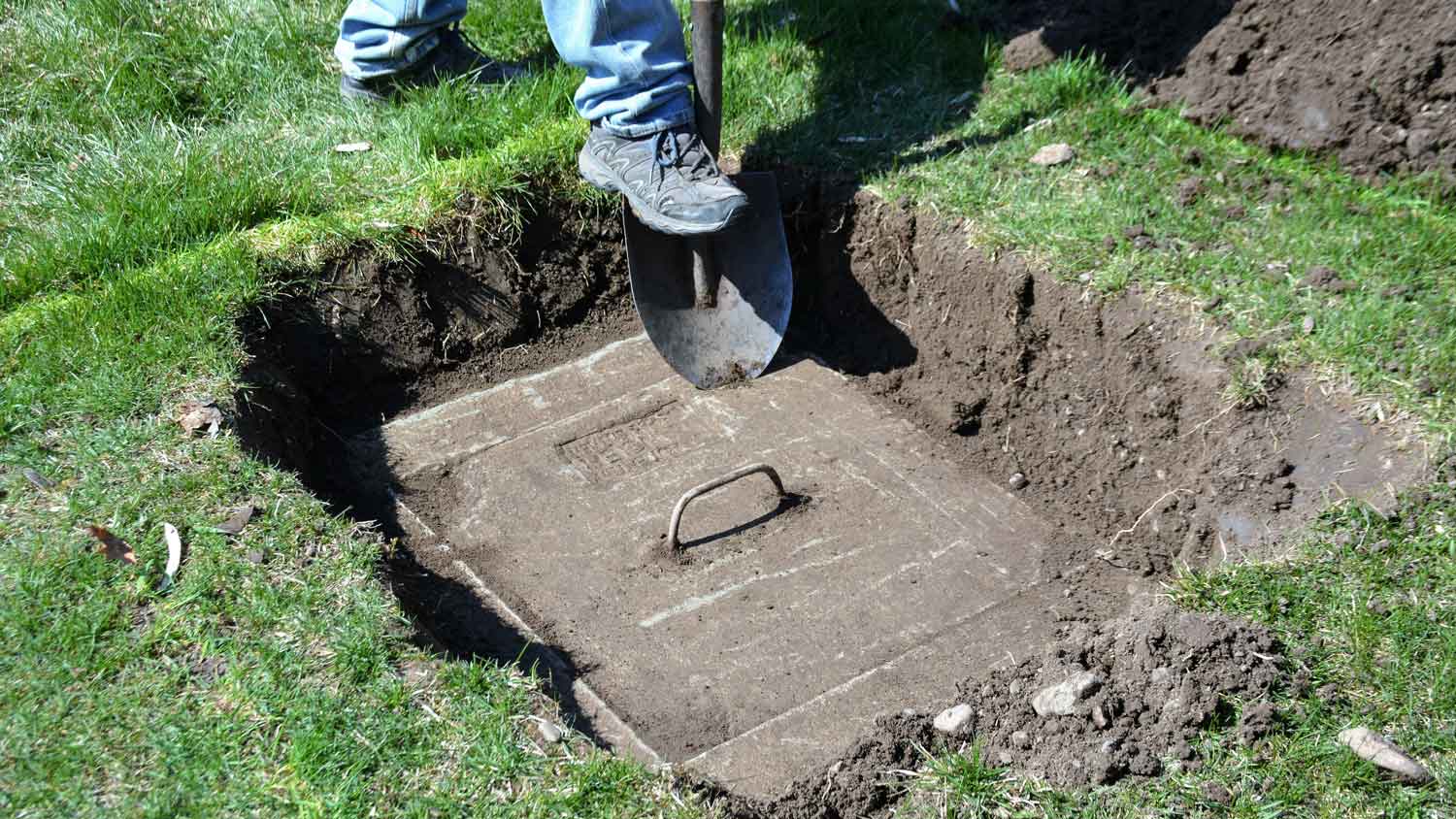How to Find Your Septic Tank in 5 (or Fewer) Simple Steps
Here are the best ways to locate your septic tank without causing a stink


In an ideal world, you wouldn’t ever have to think about your septic tank or its location on your property. Realistically, though, there are times when you need to know how to find your septic tank—for example, if you’re preparing for septic system maintenance or planning a backyard renovation project. If so, you can follow these simple steps to track down your septic tank (and, if needed, pass the information along to your septic professional or contractor).
When Would You Need to Find Your Septic Tank?
Septic tanks are underground for a couple of reasons. For one, these big, bulky tanks aren’t exactly nice to look at—if they were aboveground, they’d be an eyesore. Also, since septic tanks collect and treat wastewater from your home, they’re often pretty smelly.
So, while it’s best for your septic tank to stay buried, it’s still a good idea to understand where it is. Knowing your tank’s location makes it easier to:
Provide maintenance access
Identify septic issues earlier
Prepare to build a new structure or dig in your yard
Where Not to Look for Your Septic Tank

Before you start searching for your septic tank, it’s helpful to understand where it’s probably not buried. Septic tank professionals will aim to install your tank in a clear patch of yard away from trees, heavy structures, and drinking water sources. For that reason, you can rule out these locations when looking for your septic tank:
Near wells
Close to your home
Near trees or deep-rooted plants
Underneath patios, driveways, or other paved areas
Under sheds, gazebos, pools, or other structures
How to Find Your Septic Tank
When you’re ready to start your search, here’s how to locate your septic tank.
1. Check Your Property Documents
Your first step is to review any blueprints, maps, or other paperwork that relates to the layout of your property. Sometimes, these types of documents will include your tank’s location, which is often 5 to 25 feet away from your house.
If you can track down this information, it’s a great starting point to kick off your search. However, these documents are not essential for finding your septic tank, so don’t worry if you can’t find them.
2. Look for Visual Cues
Sometimes, there are obvious signs in your yard that can guide you to the location of your septic tank. For example, you might have a patch of grass that’s super lush and healthy compared to the rest of your lawn. This could come from sewage that leaked out of your septic tank and is now fertilizing your lawn. Or, you might notice an unusual mound or depression in the ground, which can indicate that there’s a septic tank in the area.
3. Trace the Main Sewer Line

Can’t find your septic tank using your property’s map or through visual evidence in your yard? You can find your tank’s approximate location by following your main sewer line, which connects to your septic tank. Here’s how:
Check your basement, garage, or crawl space for a pipe that’s about 4 inches in diameter. It might be made of cast iron or polyvinyl chloride (PVC).
Follow the main sewer line until you see where it leaves your house.
Walk outside to the point where the line exits your home.
Trace the potential path of the pipe in your yard. It should move away from your house in a straight line. Along the way, look for signs of a septic tank, including extra-healthy patches of grass or minor bumps or dips in the ground.
4. Inspect the Ground With a Metal Detector or Soil Probe
Now, with an idea of where your tank might be, you can use a septic tank locator tool—either a metal detector or soil probe—to confirm its location. Using a metal detector is the easier option, but if you don’t already have one, you can use a soil probe, instead. To do so, gently insert the probe into the ground in the area where you think the tank might be. If you feel any resistance or dig into a hollow section, it could be your tank.
5. Contact the Records Office in Your Area
If you still can’t find your septic tank after following these steps, reach out to your local records office. Faulty septic tanks have the potential to pollute nearby water sources and create other environmental problems, so municipalities often require septic installers to get permits before installing a new septic system. If that’s the case in your area, the office may have a map of your septic system on file.
Tips for Taking Care of Your Septic System

Practicing proper septic tank maintenance is essential to keep your septic system working smoothly and prevent potential problems. Here are some tips to keep in mind:
Schedule a septic tank inspection every two to five years.
Pump your septic tank every three to five years.
Only flush human waste and toilet paper.
Don’t dump food, grease, or chemicals down the drain.
Limit water usage.
Don’t park cars or put heavy objects on top of your drain field.
DIY vs. Hiring a Pro
Ideally, these techniques will help you find your septic tank without a professional’s help. However, if you can’t locate it or don’t want to poke around your yard looking for it, you can call a local septic tank company to do it for you. On average, septic pros charge between $125 and $250 per hour.
Similarly, if you think that your septic system might be malfunctioning, contact a pro as soon as possible. Damaged or leaky septic tanks can release toxic fumes and harm the environment, so it’s best to have an expert handle all septic tank repairs and maintenance.
Frequently Asked Questions
Septic tanks come in multiple shapes, sizes, and materials. However, they’re often round or rectangular in shape and made from concrete, fiberglass, or plastic. There’s a range of septic tank sizes, with the average model measuring 30 to 40 square feet and holding 1,000 to 1,500 gallons of waste.
There are several signs that can indicate a full septic tank. For instance, you might smell sewage around your house, hear a gurgling sound in your pipes, or notice that your drains work slower than normal. You might also see pools of water in your yard or find patches of grass that are particularly lush and vibrant.
No. You should never empty a septic tank yourself because it involves working with specialized equipment (that you probably don’t have) and puts you at risk of breathing in toxic fumes. Plus, once you’ve removed the waste, you’ll need to transport it and dispose of it safely. Instead, call an expert for this job. On average, hiring a pro to pump a septic tank costs $550.
You should have a pro pump your septic tank every three to five years. However, yours might need to be pumped less or more frequently, depending on the size of your tank, your water usage habits, and the number of people in your household. In short, the quicker your tank fills up, the more often you’ll need to pump it.


- How to Check If a Septic Tank Is Full: 7 Easy Ways
- How Often Does a Septic Tank Need to be Inspected?
- Here’s What to Put in a Septic Tank to Break Down Solids
- What to Do After Your Septic Tank Is Pumped: 4 Top Septic Maintenance Tips
- You Just Had Your Septic Tank Pumped and It’s Full Again. Now What?
- How Often to Pump a Septic Tank: What You Need to Know
- What Is a Septic Tank and How Does It Work?
- How to Find a Septic Tank Lid: 5 Easy Methods
- Are Septic Tanks Bad? Pros and Cons to Consider Before Moving Into a House With a Septic System
- Plumber or Septic Service Provider: Who Should I Call for Septic System Problems?










